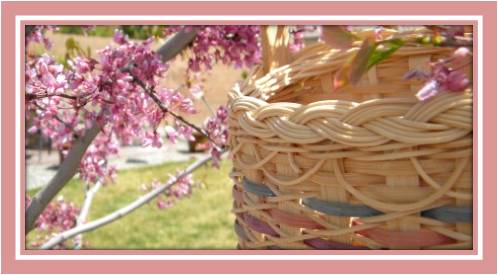
 I've had a couple of e-mails over the past week from new weavers with questions on shaping their basket. I realized I hadn't spoken much about this so I have a few tips to pass along. First let me say that these tips are for standard square/rectangular reed baskets.
I've had a couple of e-mails over the past week from new weavers with questions on shaping their basket. I realized I hadn't spoken much about this so I have a few tips to pass along. First let me say that these tips are for standard square/rectangular reed baskets.- Use plenty of clothespins especially in the first few rows. They are your extra hands. One thing I notice when teaching is that students use too few clothespins. The basket above is not large yet I have 10 clothespins on it. As I weave higher up the walls of the basket I won't need as many.
- Clothespin your corners upright. You can see easier in the top photo that I have all four corners clothespinned upright. Keep these pinned also for the first few rows, then the clothespins in the corners can be removed.
- If you are a new weaver, select patterns that use at least 3/8" or wider weavers for your first few rows. The strength of a 3/8" weaver is strong enough to help get the sides of your basket going up straight quicker. In the photo, I am weaving with 1/4" flat reed. This is a very weak reed so I will need to use more clothespins and continue using quite a few clothespins for additional rows to ensure that my basket walls are going up straight.
- One e-mail mentioned that she was weaving with the basket upright like in the top photo and she was struggling. She noticed that I turned my basket on its side like in the bottom photo. If you turn your basket on its side to weave as in the bottom photo, this helps not only the stakes on the top, but also on the bottom take their proper upright shape. One thing you do not see in my videos that I will mention here; On my videos, I weave on the table so that my webcam can see and take the picture. When I weave without a camera, I weave in my lap! I lay my old towel in my lap and weave there. My lap works the same as the table in that I have my basket turned on its side as in the bottom photo. It is much more comfortable to weave in my lap and therefore I get a better finished product.
- When starting a row of weaving, get around the first corner and STOP. Take a moment to shape that corner, add clothespins if needed. Now weave across one side of the basket and around the second corner and STOP. Get this side of weaving adjusted as needed and the corner shaped. Continue on with this pattern of stopping after going around each corner so that you can shape each side and corner just the way you want it, not too tight and not too loose so that the sides of your basket will go straight up and down rather than bend inward or flair outward (unless that is the desired shape like in THIS basket which both flairs and bends). Take your time to get it just right with each row.
- When lashing on a rim, remember rim material is considerably heaver than your other weaving material. It needs to soak longer so that you can bend it 90 degrees at each corner. What will happen if you don't is the top of your basket will be round or oval. Again, if that is your desired shape then ok, otherwise, be sure to soak it well and bend it well at each corner to keep that square shape.
- If the base of your basket is wobbly once it is woven, dampen it slightly and place a heavy book on your basket like a phone book. Let it set overnight to dry and it will be perfectly flat in the morning.
- Remember that shaping gets better with practice. The size of the basket in the photo above is a nice size to begin with for a new weaver, it is not too large or not too small. In the words of Goldilocks, "It is just right." For new weavers, be sure to start with some easier baskets to practice your shaping. Most patterns will identify themselves as either beginner, intermediate, or advanced. When you've done a few beginner patterns, spread your wings and try something more challenging. If you follow these tips and take your time, even your very first basket will be a beautiful work of art!
Have a wonderful day of weaving,
Nancy





No comments:
Post a Comment